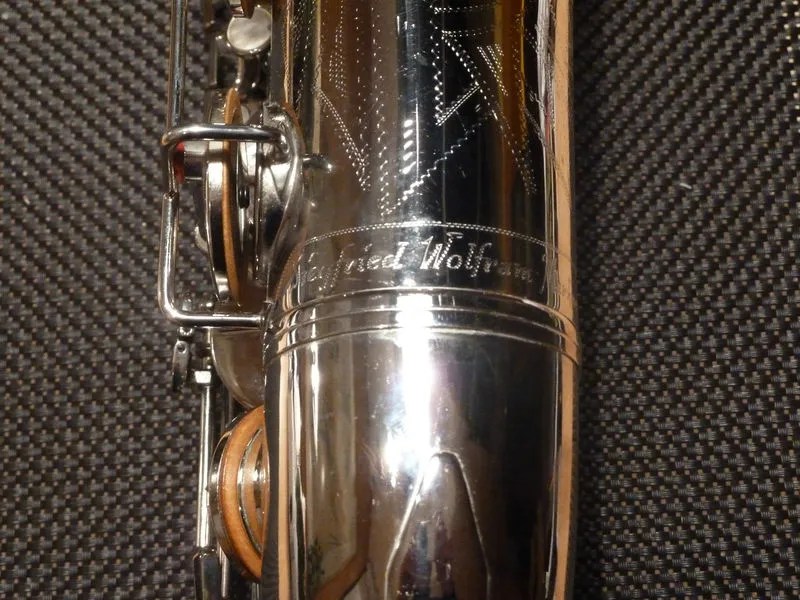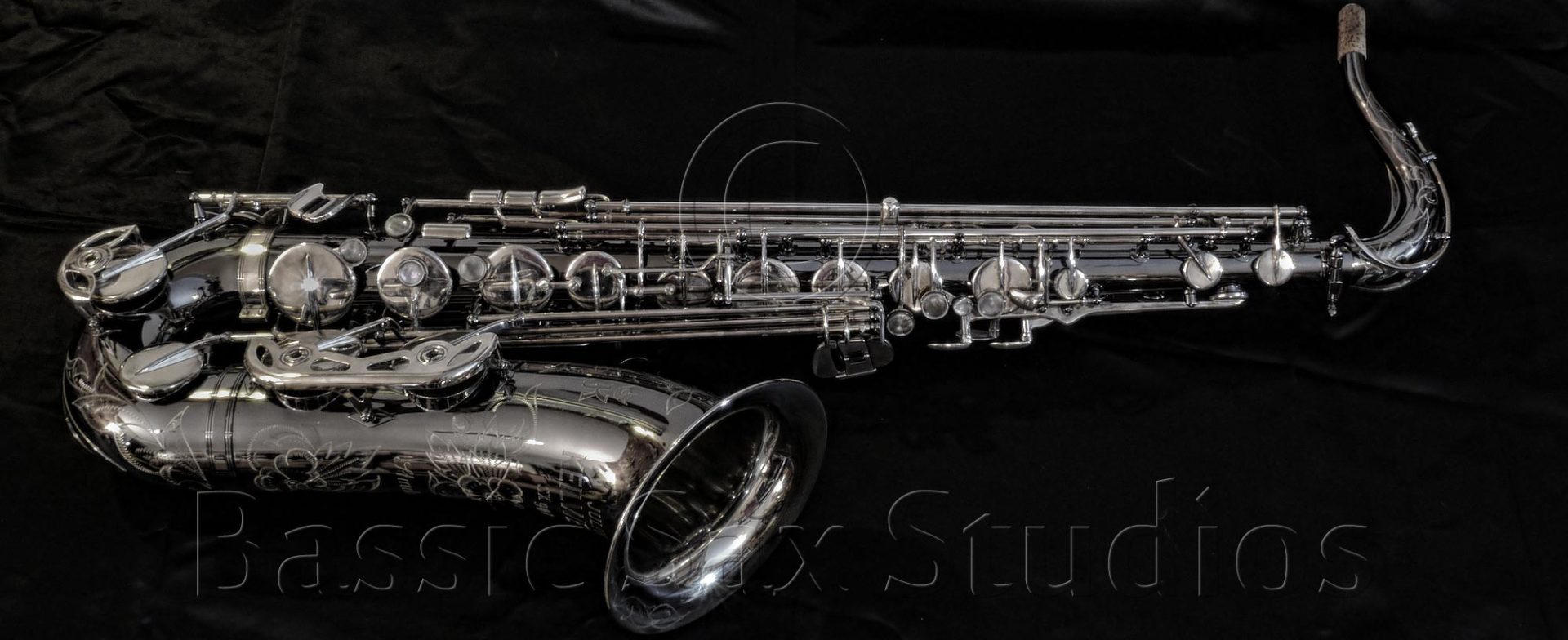
Company beginnings
Oswald Wolfram founded his company in 1945, after working for Eugen Schuster in the area of saxophone production. Oswald began his company with the manufacturing of brasswinds, with saxophone production starting in 1948. Between 1945 – 1948, Oswald’s son, Siegfried, worked for his father and learned the trade of brass instrument maker. He followed this with saxophone builder, and by 1952 had earned his Master Craftsman’s diploma in saxophone manufacturing.
In 1956 Oswald split the business with his son. Oswald took over the brasswind division and built brass instruments until 1965, while Siegfried assumed the saxophone division. Until 1966 the company operated under its own name, although often the saxophones carried the extra name MIGMA.1
Below are two horns that illustrate different engraving on Siegfried Wolfram saxophones. The first has no MIGMA engraving, only the name Siegfried Wolfram.

The second doesn’t have the Wolfram name at all, only MIGMA on the bell.

Wolfram joins PGH/Sinfonia
In 1966 Wolfram joined the Produktionsgenossenschaft des Handwerks—the English translation of which would be: the manufacturing cooperative of skilled trades—(PGH/Sinfonia). Joining PGH/Sinfonia (which would become VEB Sinfonia in 1972) resulted in a fundamental restructuring of the way their musical instruments were produced.2
As a result of joining PGH/Sinfonia, fewer Wolfram saxophones were produced each year, until, in 1969, saxophone production ceased altogether. Afterwards, as part of PGH/Sinfonia, Siegfried Wolfram specialized in the production of saxophone parts such as keys. In 1990, Siegfried Wolfram once again became an independent entrepreneur, and specialized in the area of component parts for musical instruments. His company continuously expanded the range of articles that they produced, and since 2007 Siegfried’s grandson, Franz, has run the company.
Facts & Figures
In each of the 21 years (1948-1969) that the Wolfram saxophones were in production, there were approximately 50 altos and tenors made. (Somewhat less during their PGH/Sinfonia years.) They had rolled tone holes, but did not have serial numbers, nor a particular brand name. These saxes were mostly sold in Eastern bloc countries.
Finishes available
According to the communications3 that Uwe Ladwig had with members of the Wolfram family, the following finishes were available:
- Silver plated with gold lacquer treatment inside bell
- Nickel plated
- Two-tone with lacquered body and silver plated keys
The electroplating was outsourced to Horst Schmidt, in the town of Markneukirchen, while the lacquer work was done in-house.
Similarity to Eugen Schuster horns
As I mentioned at the top, Oswald Wolfram founded his company originally after working in the area of saxophone production for the Eugen Schuster company. This previous work history of his, could explain the similarity that the Wolfram horns had to the Schuster saxophones. Specifically, the left pinkie clusters of the two saxophone brands, look remarkably alike. Here is a Wolfram tenor…

… and this is a Eugen Schuster “Majestic” model alto…

At this point I don’t yet have many examples of Wolfram saxophones in my Bassic Sax Pix gallery. This makes sense, when you consider that so few of them (circa 1000) were produced in total. All in all, these Wolframs are quite rare saxophones.
If you have a Wolfram saxophone that you would like to contribute to the gallery, please let get in touch with me. I’d love to hear from you. Thanks!
___________________________________________________________________________________________________________
1 MIGMA is the the acronym for: die Musikinstrumenten-Handwerker-Genossenschaft Markneukirchen. Translated, that would mean: Musical Instrument Manufacturer’s Cooperative Markneukirchen.
They are not a manufacturer of instruments, rather they partner with master craftsmen and dealers specializing in instruments from Markneukirchen. According to their site, since 1943 they have been marketing, selling, and distributing: strings, bows, guitars, brasswinds, Orff instruments, drummer’s sticks and mallets, accessories, as well as component parts.
2 Klappenfranz – Fa. Siegfried Wolfram
3 Saxophone: Ein Kompendium, by Uwe Ladwig. Second edition 2012, p. 140.




You must be logged in to post a comment.